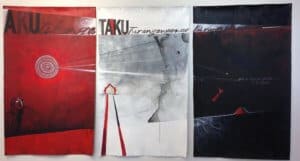Erena Koopu with some of the art works at her Master of Māori Visual Arts Hei Kai thesis exhibition.

From student to teacher to student once again, Toihoukura senior painting lecturer Erena Koopu says art and learning have always been a part of her life.
Erena usually spends her time in the classroom teaching students, but last year part of this time was spent completing a thesis for her master’s degree.
One of the first students to graduate from the university programme, Erena is now responsible for Toihoukura’s Te Toi o Ngā Rangi: Bachelor of Māori Visual Arts.
“Since childhood, art has played a major role in my life,” she says. “It is my true passion and has been the motivation for my pursuit of higher education, and has shaped the pathway to my vocational choices.”Her return to self-directed study resulted in her Master of Māori Visual Arts Hei Kai thesis exhibition.
Erena’s Hei Kai report details the journey undertaken in producing the exhibition, which was conceived following the 50-year anniversary
of the poukai celebrations at Kōkōhīnau marae, Te Teko, in 2013.
The report explores the history and tradition of the poukai by the Kīngitanga in the early 1800s. It then examines the establishment of the first poukai held
at Kōkōhīnau marae in 1963 under the guidance of Eruera Manuera.
Inspired by the deeds of Manuera in his key role as iwi leader – and equally, says Erena, as her great grandfather – merged with the whakatauki, “Ko te
kai a te rangatira he kōrero a te rangatira hei kai”
(the food of the leader is knowledge, it sustains him) – the exhibition and the report explore the idea of Māori leadership in a kaupapa-based modern-day context and look at pivotal questions.
What is a rangatira? How does one achieve this status? How do rangatira sustain themselves in such culturally critical roles?
The body of art works created for the Hei Kai exhibition comprises eight paintings, each one focusing on a specific quality of a rangatira.
“In particular, I use examples of Manuera’s attributes and his involvement in poukai to centralise and focus my art practice throughout the creative
component of this thesis,” says Erena.
“These are aroha, whakapono, whanaungatanga, kai, kōrero, whenua, tikanga and marae.” (Love, to believe and trust, relationships and connection,
food, conversing, land, Māori custom and marae.”
Erena undertook master’s degree studies as part of her EIT professional development.
“I am inspired by rangatahi and their perspectives on the world in which they live. To this end, I have enjoyed the challenges, rewards and fulfilment
that have come with teaching at college level and currently in the tertiary sector.”
Teaching at EIT allows her to explore art in a completely different framework, she says, encompassing all aspects of te Ao Māori for students who may have little to no experience of a completely Māori world view of art and its related protocols.
“The support of my whānau, iwi and hapū keeps me grounded, focused and moving in a direction where I feel my skills are most needed.”
